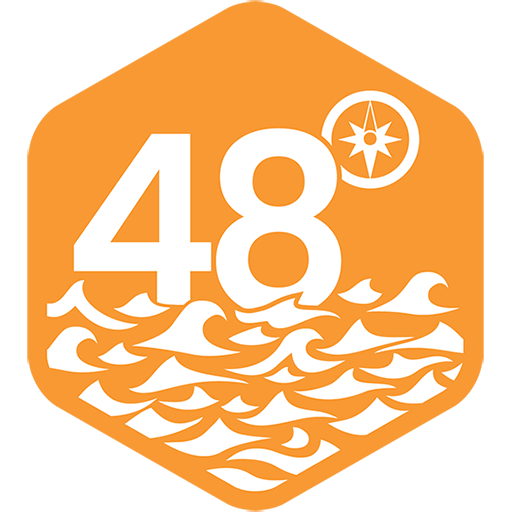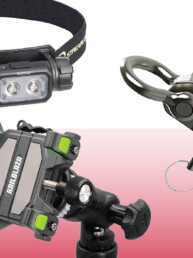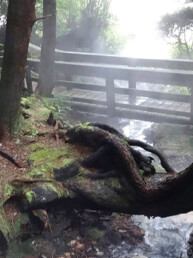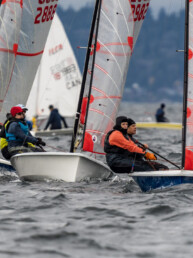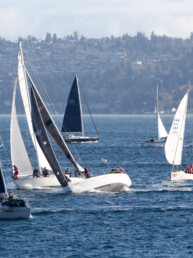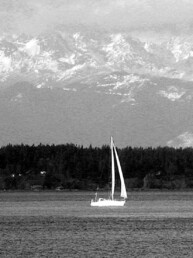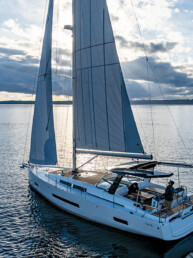Last month, we introduced the 48° North community to Seattle sailor David Linger. Dave’s recent completion of a singlehanded circumnavigation as a part of the Global Solo Challenge (GSC)—which he completed in 175 days nonstop save for a 9-day pause to repair a broken boom just past Cape Horn—puts him on a very short list of sailors from this region who have successfully circled the globe alone, especially as a part of a race. This month, we’ll hear more about his journey.

“Even an Old, Slow Class 40 Rips”
When we left off, Dave had just stepped aboard his new-to-him Class 40, Koloa Maoli—named after the Hawaiian species of duck and in honor of the name his mother, who was raised in Hilo, had given their family’s first sailboat—for the trip across the Atlantic to the start of the Global Solo Challenge in A Coruña, Spain. Through that journey and the much bigger one to follow, I was curious to know Dave’s opinions about how Koloa Maoli, one of the first generation Class 40s built in 2006, sails.
Dave thought the boat was a good size for this purpose and began with this: “I had always admired the Class 40, and I’d followed the class since its inception 20 years ago.” More than 200 Class 40s have been built and, as the class has grown and gotten more expensive and professional, Dave says, “There’s a sub-market for pointy boats, as we call them, for adventure racing.”
When it comes to sailing, Dave said, “The A2 is intimidatingly large, but fractional spinnakers are a sweet spot because you don’t have to worry about getting it down if the wind picks up to 25.” He did have a couple of furling sails, but most of his spinnakers had sock systems for singlehanded management. “With a fractional A3 and a reef in the main, you’re good up to almost 30.”
Dave continued enthusiastically, “Doing 12, 14, 16 knots was super easy, all day long. My keel hits a harmonic at 14.5, not 14.2, not 14.8, so I have an audible reference point. You can be sitting down below going that fast. If the boat is balanced and the swells are not coming from an odd direction, it’s super chill. Even an old, slow Class 40 rips.”
Dave was typically able to sail upwind at about 8 knots, and if he beared away from the breeze maybe 20 degrees, he could easily jump to 12-14, with smooth acceleration. Though he saw speeds of up to 23 knots, he told me, “It starts to get hard to sleep if you’re doing 14-18, I would get a little nervous and it would be hard to relax.”
When breeze trended in the other direction, Dave quickly learned to adjust water ballast before changing to a bigger sail. Letting some of the 750 liters of water out of the ballast tank could make a seemingly underpowered boat find its groove again, with much less effort from the solo sailor aboard.

A Challenge Indeed, and A Lot of Time Alone
Imagine the first day of a round-the-world journey. I basically can’t. Then, imagine all that build up to that one huge moment, and… then delaying a day. The weather was positively nasty for Dave’s start of the Global Solo Challenge. So everyone stayed on the dock. Dave recalls, “It was blowing 45-50 knots. And we were like, ‘Nope.’” Even waiting, the fleet still wound up beating into 35 knots the day they left. It was rough.
In that mess, Dave recalled, “I was functional, but I was as seasick as I’ve ever been. You drink some water because it makes it more comfortable to throw up again.” The good news for Dave was after that gnarly start, no more sea sickness for the rest of the trip. “Once I was done with that, I was done with that.”
The route for the Global Solo Challenge brings sailors south through the Atlantic and then east-about via the three great capes. The scale of the voyage is self-evident and Dave tried not to think about that too much, and he soon found the routines that would keep him happy, healthy, and able to continue. He originally thought the trip might take him about 150 days, but his speed kept him closer to 165, plus his unplanned stop in Argentina.

Even though this was ten times as long as his previous longest solo trip, Dave says he did ok with the alone time. “I’m a bit of an introvert, and I may have some ADHD tendencies which turned out to be quite helpful for something like this.” In perfect concert with this self-assessment, our conversation stopped as Dave watched and narrated from the porch of his Eastlake floating home, “A crow is chasing an osprey trying to get it to drop its fish. No shortage of distractions around here.” It was the first of several pauses in our conversation so that Dave could take in the natural wonders around him. It was, frankly, delightful. Not long after, the interview was again sidetracked so Dave could introduce me to the two ducks—“Sid and Nancy” he says—who stop by regularly for a snack of peanuts he keeps in a big bag near the door. Not only was this a fun window into one aspect of a fascinating person, but I genuinely think this relationship with nature and ability to find entertainment in many forms helped keep Dave sane while being alone for so long.
Of course, Dave was also in very frequent contact with the outside world. As mentioned in the first part of this story, his communications system was extensive—centered around the combination of Garmin InReach, Iridium Go, and Starlink. He described InReach as the primary, and folks would text him via InReach and prompt him to turn on Starlink, because, “They want to send me a picture of the cat, or a picture of Duck Dodge” since they were still out sailing Dave’s Ranger 33 while he was away. He said, “If the power system is feeling happy and robust, you can run Starlink and then you can WhatsApp all day on that. I would talk to my sister every couple of days, and talk to my girlfriend Lillian most days.”
Other than the sheer volume of time, aspects of the race made the alone time harder. In part one, Dave described his emotional response to sailing past the spot where a racer in the Cap-Martinique race had perished after being washed off his boat in a storm just a few days before. But there were tough times like that throughout this race, ones that brought at least introspection if not outright sadness and increased caution. Sailing past the locations where fellow competitors had to be rescued from their boats loomed large—Canadian skipper William MacBrien was rescued from his flooded boat, and American skipper Ronnie Simpson dismasted in rapidly deteriorating conditions 650 miles off the coast of Argentina. Dave noted that it was very important for him to be able to call his sister in those moments and say, “This is really stupid and I don’t know how to feel about it, but I don’t want to talk to Lillian about it because I don’t want it to worry her.” To which his sister would retort, “Really, so you call me instead?!”
A Broken Boom
If there’s one wild story from Dave’s circumnavigation to focus on, it has to be breaking his boom just a few days from reaching Cape Horn. In general, Dave loved sailing in the Southern Ocean, but it was certainly intense. The response to the damage is more of a story than the incident, but here’s how it happened.
Dave was broad reaching in 25-30, on track to reach Cape Horn in about four days. He was already monitoring a big weather system building behind him, and hoped to get around the Horn before he was wind-bound on the west side for who knows how long. He says, “Boat speeds were good, just trying to keep things in the low teens.”

In recalling the boom break, Dave harkened back to some video he took earlier in the race, in which a nasty breaking wave knocked Koloa Maoli down while he was on deck, fracturing his ribs as he fell onto the stainless steel tiller end. He was matter-of-fact in his comparative description, “The wave that broke the boom was about the same size as that one, but it had two crests instead of one. I was outside, holding onto the vertical posts that hold up the hard top. The wave breaks over the boat and knocks it over, and there’s all this water in the main—which was double-reefed, so there were big pockets to hold water. The second crest washed over and filled the main up, and the boom broke sideways, it was too much of a side load.”
Dave’s immediate reaction was one we could all relate to, “Oh f*ck, it’s broken.” At a glance, he suspected it might not be repairable, but that was a secondary priority. “I needed to get around the corner first.” In quick seamanlike fashion, he pulled the main down and ran sheets through the second and third reef points, then aft to snatch blocks to trim it. Then he put the main back up, and cleaned up what he could so he could jibe. “I had four or five jibes to get around Cape Horn. It was a big, sloppy mess—the sail would start across and you give the battens a little lift up in the air and the whole mash would go crashing across to the lifelines on the other side.”
With the big system on the horizon, he was in a race against time. His jury rig worked in the present winds and sea state, but there was no way to know what might happen if conditions worsened. He continues, “I couldn’t slow down any more than I had already, otherwise I was going to get closed out by a 50-knot gale on the west side of Patagonia, which is a bad place to be. My level of stress was a 7 out of 10. The night before I went around Cape Horn was the darkest night of the trip. There was no moon, there were clouds, there was no light—it was mineshaft dark, and all I wanted to do was be down below. It was almost spooky. And you’re heading toward rocks.”
When it started to get light in the morning, Dave peered out of the hatch and could see the most magnificent rocks, and the infamous Cape Horn behind them. Dave sailed as close as he felt comfortable, took a couple of pictures, and pulled off a jibe. He recalls, “The lighthouse keeper is talking to you on the radio, and they’re calling you by name because they’ve been watching you approach, and they’ve talked to all your competitors.”
No sooner did Dave have his mystical Cape Horn experience than the reality on the far side came slamming in. “Goddamn, I had to pull off another jibe. And I was talking to Macro, the race organizer, about where and when I’m going to suspend my race so I can motor up the Beagle Channel to make repairs in Ushuaia, Argentina. Jason Christenson from Racing the Wind was helping me from Seattle with timing and weather to get to and around Cape Horn and into port.” On top of that, Dave now had to motor into all that weather he avoided getting around the corner, and there were times when his little 27 horsepower engine just couldn’t keep up and Koloa was pushed backward at a knot-and-a-half under bare poles at full throttle.
Then, the question was, if and how this repair could be made? Dave says, “We got some really good support, ideas, and help from the Northwest community. Simon Miles from 206 Composites would have flown down but was otherwise booked, but we still talked with both Simon and Paul Bieker.” The consensus was, if they could get the right materials with the right expertise to the boat’s location, the boom was fixable. But that might have been the most extraordinary challenge of all.

Dave’s girlfriend, Lillian Miller Kuehl—a maritime professional and a major part of Dave’s shore team—jumped into action and was crucially instrumental in connecting the dots of this very complicated project. Through the global Women Who Sail Facebook group, Lillian identified a carbon specialist based in Buenos Aires, Eze Siroto, who along with his experienced friend, Mamu Caputo, could make the repair. Lillian hand-delivered the carbon fiber to Buenos Aires. Eze could get the right epoxy, but since there weren’t commercial freight flights to Ushuaia—only passenger planes, on which you can’t bring epoxy—they would have to drive. So Lillian, Eze, and Manu, with all the essential repair materials in tow, would have their own grand adventure driving 3,000 kilometers south through Argentina to Dave and Koloa Maoli.
They were all there for about nine days, and after so much rigamarole getting there, the repair went very smoothly thanks to the expert work by Eze and Manu, with Lillian helping out with sail repairs. Dave appreciated the opportunity to catch up on sleep and rest his body, but best of all was the chance to spend unexpected time with Lillian in the middle of his voyage. It was already true that Dave likely couldn’t have completed this massive endeavor without Lillian, but now that fact was blatantly obvious to anyone paying attention. Her work, vision, support, skills, and personal commitment enabled Dave to continue.
The days passed quickly, and soon it was time to go again and finish what he’d started. Dave says “I should have stayed an extra two days, because then I would have missed the storm just north of the Falklands that tried to kill me. That was the worst part of the trip. It blew 50-plus for almost 36 hours. It ripped one of my hydro-generators off the back of the boat, sheared one of the locating pins for my tillers so my two tillers were pointing at each other, and it trashed one of my autopilot drives.”

Closing the Loop
After the drama of the boom repair and the rough conditions out of Ushuaia, the rest of the trip was as routine as a solo ocean passage might be. Dave was in his element, in a well-worn groove of experience after several months of sailing just like this.
If you want to read more about the end of Dave’s race, head back to the beginning of the first part of Dave’s story. After that final northeast transit of the Atlantic, Dave sailed back into A Coruña 175 days after he’d sailed away, and became a solo circumnavigator. He finished sixth in the Global Solo Challenge, an accomplishment I’m not sure he’s as proud of as his hard-won burgee as a part of the International Association of Cape Horners. Lillian met him at the finish and, as promised, Dave finished the race and didn’t make a fool of himself coming into the dock.
It’s hard to know where Dave will go from here. But with his personal fleet of boats and remarkable experience, I’d say he can sail pretty much anywhere. When we sat down, he was focused mainly on that evening’s Duck Dodge, and the SEVENTY48 race in which he’d be rowing Lillian’s boat hardly a month after his return from Spain (which he successfully finished). Soon, he and Lillian will be heading to Spain to bring the good ship Koloa Maoli back to Maine.
Joe Cline is the Managing Editor of 48° North.
Joe Cline
Joe Cline has been the Managing Editor of 48° North since 2014. From his career to his volunteer leadership in the marine industry, from racing sailboats large and small to his discovery of Pacific Northwest cruising —Joe is as sail-smitten as they come. Joe and his wife, Kaylin, have welcomed a couple of beautiful kiddos in the last few years, and he is enjoying fatherhood while still finding time to make a little music and even occasionally go sailing.
